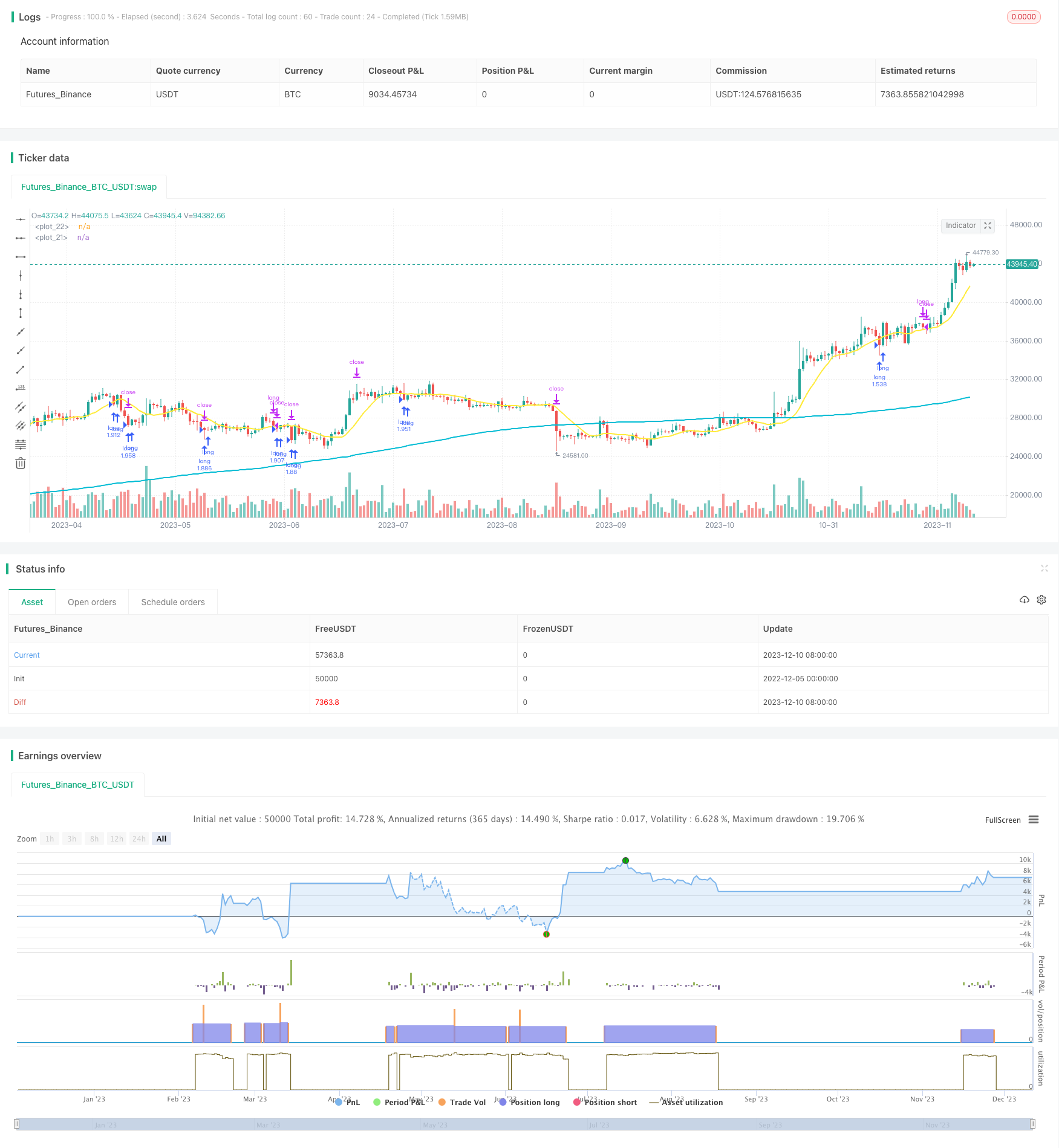
该策略通过跟踪长期趋势,在短期拉回时进入场内,实现低买高卖的简单交易逻辑。
策略原理
当收盘价高于200日简单移动平均线时,表示目前处于长期上涨趋势中。当收盘价低于10日简单移动平均线且RSI(3)低于30时,表示价格短期内出现了较大幅度的拉回。这时入场做多,可以以较好的价格跟踪长期上涨趋势。
当做多头仓位后,设置止损线和止盈线。具体来说,止损线为入场价格的95%,止盈线为入场价格的120%。当价格上涨突破10日线时止盈;当价格跌破前一根K线的最低价时止损。
优势分析
该策略最大的优势在于,通过跟踪长期趋势,在短期调整时选择较好的入场点位。从长期来看,股票指数整体处于上涨通道,该策略可以有效跟踪长期上涨趋势。
从短期来看,该策略选择的入场时机处于短期超跌阶段,具有一定的低吸效应。RSI(3)低于30表示价格出现了三根K线的连续下跌,这为 Entry 提供了更好的时点。
风险分析
尽管有止损机制的保护,该策略最大的风险还是来自趋势判断错误。如果判断长期趋势错了,那么入场之后可能会遭遇较大的亏损。此外,止损位置设置过于接近也可能增加风险。
解决方法之一是加入更多的趋势判断指标,如ADX,确保入场时确实处于趋势状态。此外,可以适当放宽止损范围,例如扩大至入场价的90%。
优化方向
该策略可以从以下几个方面进行优化:
加入更多的趋势判断指标,确保更准确判断长短期趋势;
优化移动平均线的周期参数,寻找最佳的参数组合;
测试不同的止盈止损参数设置,找到最优的参数组合;
尝试在入场时加入其他因子判断,如成交量放大等,以提高入场的效率。
总结
该策略主要思路是跟踪长期趋势,在短期调整时选择较好的入场点位。它最大的优势是入场价格优化,能够实现低买高卖,长期跟踪上涨趋势。同时,策略也考虑了风险控制,设置了止损机制。总的来说,这是一个非常简单直接、容易理解和实现的趋势跟踪策略。通过一些参数和规则的优化,可以进一步提高策略的效果。
/*backtest
start: 2022-12-05 00:00:00
end: 2023-12-11 00:00:00
period: 1d
basePeriod: 1h
exchanges: [{"eid":"Futures_Binance","currency":"BTC_USDT"}]
*/
// This source code is subject to the terms of the Mozilla Public License 2.0 at https://mozilla.org/MPL/2.0/
// © tsujimoto0403
//@version=5
strategy("simple pull back", overlay=true,default_qty_type=strategy.percent_of_equity,
default_qty_value=100)
//input value
malongperiod=input.int(200,"長期移動平均BASE200/period of long term sma",group = "パラメータ")
mashortperiod=input.int(10,"長期移動平均BASE10/period of short term sma",group = "パラメータ")
stoprate=input.int(5,title = "損切の割合%/stoploss percentages",group = "パラメータ")
profit=input.int(20,title = "利食いの割合%/take profit percentages",group = "パラメータ")
startday=input(title="バックテストを始める日/start trade day", defval=timestamp("01 Jan 2000 13:30 +0000"), group="期間")
endday=input(title="バックテスを終わる日/finish date day", defval=timestamp("1 Jan 2099 19:30 +0000"), group="期間")
//polt indicators that we use
malong=ta.sma(close,malongperiod)
mashort=ta.sma(close,mashortperiod)
plot(malong,color=color.aqua,linewidth = 2)
plot(mashort,color=color.yellow,linewidth = 2)
//date range
datefilter = true
//open conditions
if close>malong and close<mashort and strategy.position_size == 0 and datefilter and ta.rsi(close,3)<30
strategy.entry(id="long", direction=strategy.long)
//sell conditions
strategy.exit(id="cut",from_entry="long",stop=(1-0.01*stoprate)*strategy.position_avg_price,limit=(1+0.01*profit)*strategy.position_avg_price)
if close>mashort and close<low[1] and strategy.position_size>0
strategy.close(id ="long")